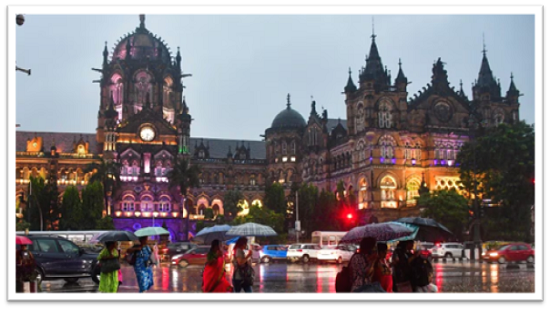
Mumbai’s Monsoon Ends Early – What to Expect as the City Heads Toward Diwali
Mumbai’s monsoon season officially retreated on October 10, earlier than in recent years. Though light showers may continue intermittently, meteorological forecasts suggest that the coming week will bring dry, calm weather and partly cloudy skies.
This year, the monsoon arrived early on May 26 and concluded by October 10 — a withdrawal date that marks the earliest exit since 2018, according to media reports and government announcements. Typically, Mumbai’s monsoon recedes between October 10 and 15, but in recent years, the timing has grown more unpredictable. Historically, the monsoon has withdrawn as early as September 30 (in 2002) and as late as October 28 (in 2020).
Rainfall Recap: Surplus Downpours and Distribution
Overall, Mumbai saw above-average rainfall this monsoon season. Suburban Santacruz recorded about 3,112 mm, which is roughly 34 percent above its typical annual average of 2,318.8 mm. Meanwhile, Colaba (south Mumbai) received 2,263 mm, an 8 percent surplus over its historical average of 2,094 mm.
Despite seasonal rainfall surpluses, the spatial distribution was uneven. Colaba received fewer rains than expected on many days, but saw some intense spells (notably June 16–21 and September 24–29). Suburban areas, particularly Santacruz, recorded heavier-than-usual rainfall through August and September, driving up the overall totals.
Mumbai also experienced five days of very heavy rainfall (over 100 mm in a single day) this season. The new head of IMD Mumbai, Bikram Singh, noted that monsoon withdrawal in Maharashtra was slightly delayed due to prevailing weather systems, but affirmed that the early withdrawal in Mumbai is still notable in recent years.
What Changes Now: Weather Outlook Through Diwali
Even though the monsoon is officially over, meteorological experts caution that Mumbai may yet witness occasional light showers before Diwali. Residual moisture in the atmosphere and weak systems could produce isolated drizzle in some suburbs.
However, the dominant trend will be toward stable, relatively dry weather. Days are expected to be warm, with maximum temperatures hovering in the low 30s °C, while nights see modest relief. Humidity will gradually decline, offering more comfortable evenings.
Over the next week, skies are likely to remain partly cloudy to clear, with limited chances of substantial rainfall. This shift toward dryness offers Mumbaikars a respite from the intense wet months and a more predictable stretch heading into Diwali.
Implications for Mumbai: Beyond the Forecast
• Water Supply & Urban Resilience: Mumbai’s water reservoirs are now in a favorable position after a wet monsoon. With surplus rainfall, supplies for municipal consumption and groundwater recharge are likely in good shape. Nonetheless, managing water distribution and ensuring adequate storage during the post-monsoon dry run remains critical.
• Infrastructure & Urban Services: With fewer downpours, the pressure on stormwater drainage systems, roads, and transport corridors will ease. Municipal agencies can use this window to inspect and clear drains, repair damaged roads, and improve drainage resilience ahead of the dry season.
• Festive Travel & Outdoor Planning: In the lead-up to Diwali, dry weather opens the door for safer road travel, fewer disruptions, and better planning of outdoor events. Vendors, pilgrims, and visitors can expect more reliable weather conditions, easing logistical challenges that often accompany unpredictable rain.
• Air Quality and Health: Dry weather may worsen air quality in certain pockets, especially in the evenings, due to reduced wet cleansing of pollutants. Residents with respiratory conditions should be alert. On the positive side, reduced humidity and clearer skies make for more comfortable conditions overall.
A Cautious Optimism: Preparing for the Transition
While the withdrawal of the monsoon brings welcome clarity, certain caveats remain. Atmospheric remnants or weak systems may sneak in isolated showers, particularly in suburban zones. Forecasts should be tracked closer to Diwali for any weather surprises.
Meteorological agencies and municipal departments must remain vigilant. Now is an opportune moment to finalize pre-winter infrastructure audits, public utilities checks, and early heat or pollution advisories. The next few weeks represent a buffer zone — bridging the monsoon’s retreat and the onset of winter.
Mumbai’s early monsoon end underscores shifting climatic variability. But if managed with foresight, the city’s transition into drier months can serve as an example of climate-aware planning in rapidly urbanizing India.





